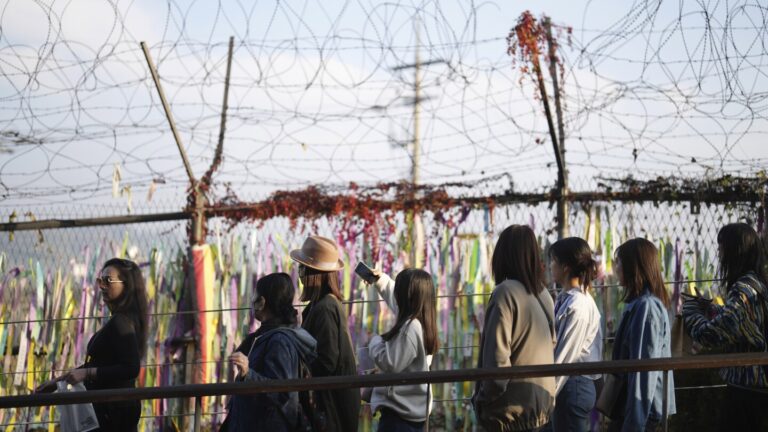SEOUL, South Korea (AP) – North Korea on Thursday fired a new intercontinental ballistic missile, the first test of a weapon designed to threaten the U.S. mainland in nearly a year, following a test conducted days earlier. . us elections.
According to the Ministry of Defense, North Korean leader Kim Jong Un ordered the missile test and was present at the launch site, saying the launch was an “appropriate” test demonstrating Pyongyang’s determination to counter enemy moves that threatened North Korea’s security. “Military action.”
The United States, South Korea and Japan also recognized the weapon as an intercontinental ballistic missile (ICBM) and condemned the launch, saying it would escalate tensions. The launch came amid warnings from Washington that North Korean troops were wearing Russian military uniforms. heading to ukrainelikely to strengthen the Russian military and enter the war.
North Korea confirmed the launch hours after neighboring countries detected the launch of a new, more mobile weapon targeting the U.S. mainland. North Korea typically explains its weapons tests the day after they are conducted, so this The statement was made with unusual speed.
“I assure you that North Korea will never change its course of strengthening its nuclear forces,” Kim said in a statement from North Korea’s Ministry of Defense carried by state media. DPRK is an abbreviation for Democratic People’s Republic of Korea and is the official name of North Korea.
South Korea’s Joint Chiefs of Staff said North Korea may have tested a new solid-fuel long-range ballistic missile. Missiles with solid propellants are easier to move and hide, and can be launched faster than those with liquid propellants.
JCS spokesman Lee Sung-joon said the launches may have been timed to coincide with the U.S. election, with the aim of strengthening North Korea’s future negotiating power. He said North Korea’s missiles were fired at a high angle, apparently to avoid neighboring countries.
Japanese Defense Minister Gen Nakatani told reporters that the missile’s flight time was 86 minutes and its maximum altitude was more than 7,000 kilometers (4,350 miles), exceeding corresponding data from previous North Korean missile tests. South Korean military spokesman Lee said South Korea had a similar assessment of Thursday’s launch.
KCNA said the flight characteristics of this launch exceeded those recorded in previous missile launches, but did not elaborate on the differences.
US National Security Council Spokesperson Sean Savet said the launches were a “gross violation” of several UN Security Council resolutions, calling them “unnecessarily escalating tensions and destabilizing the regional security situation.” There is a risk of it happening.” Savet said the United States will take all necessary measures to ensure the safety of the American mainland and allies South Korea and Japan.
South Korea and Japan condemned North Korea’s launches as a threat to international peace and said they were working closely with the United States over recent North Korean weapons tests. Lee said South Korea and the United States are planning “sufficient” bilateral military exercises and trilateral military exercises involving Japan to counter the threat from North Korea.
Lee said the missile may have been launched from a 12-axis launcher, the largest mobile launcher North Korea unveiled in September. The unveiling of the vehicle fueled speculation that North Korea was developing a larger intercontinental ballistic missile than existing ones.
Although North Korea has made advances in missile technology in recent years, many foreign experts believe the country has not yet acquired a functioning nuclear-tipped missile capable of attacking the U.S. mainland. They claim that North Korea likely possesses short-range missiles capable of nuclear strikes across South Korea.
One of the technological hurdles North Korea still faces is whether its weapons can withstand the harsh conditions of atmospheric entry. South Korean officials and experts earlier said North Korea may test-fire an intercontinental ballistic missile (ICBM) at a conventional angle to test its capabilities.
Lee said high-angle launches like Thursday’s test cannot test the missile’s reentry vehicle technology. He said further analysis was needed to determine why North Korea did not conduct a standard orbit launch on Thursday.
Korean military intelligence agency he told lawmakers Wednesday. North Korea is close to testing a long-range missile capable of reaching the United States, and is likely to have completed preparations for its seventh nuclear test.
North Korea last tested an intercontinental ballistic missile in December 2023, when it launched the solid-fuel Hwasong-18.
Over the past two years, Kim has stepped up weapons tests and threats in the wake of Russia’s invasion of Ukraine, while also expanding military cooperation with Russia. South Korea, the United States and others recently accused North Korea of sending thousands of troops to support Russia in its fight against Ukraine. They said North Korea is already shipping artillery, missiles and other counterflow weapons to Russia.
The possibility of North Korea joining the war in Ukraine would indicate a serious escalation. South Korea, the United States, and its partners are also concerned about what North Korea could get from Russia in return for joining Russia’s war against Ukraine. Apart from the soldiers’ salariesexperts say Kim Jong Un likely wants to acquire high-tech Russian technology that could perfect nuclear-capable missiles and build reliable space-based surveillance systems. Mr. Kim wants Russian fighter jets and may help North Korea modernize its conventional weapons.
On Wednesday, Defense Secretary Lloyd Austin said North Korean troops were wearing Russian military uniforms and carrying Russian equipment. Moving to Ukrainewhich he called a dangerous and unstable development. Mr. Austin said it was “very likely” that Russia would use its troops in combat.
Austin spoke with South Korean Defense Minister Kim Yong-hyun at a press conference in Washington. Last week, South Korean President Yun Seok-Yeol raised the possibility of supplying weapons to Ukraine, while stressing that the government “cannot stand by and watch” reports of North Korea dispatching troops.
South Korea announced Wednesday that North Korea had sent more than 11,000 troops to Russia, with more than 3,000 of them being moved near battlefields in western Russia.
___
Follow AP’s Asia-Pacific coverage. https://apnews.com/hub/asia-pacific

